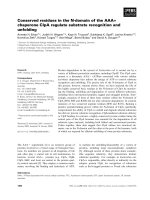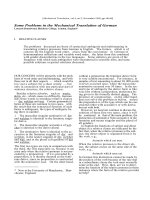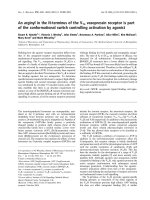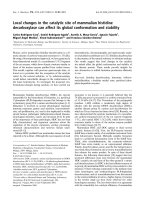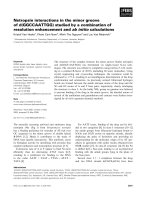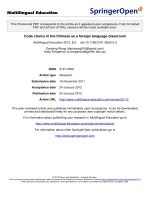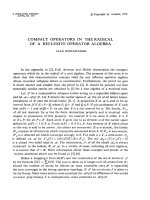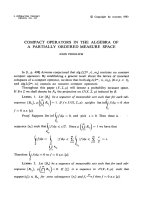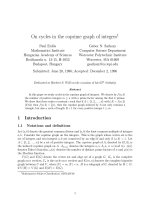Báo cáo toán học: "On cycles in the coprime graph of integers1" docx
Bạn đang xem bản rút gọn của tài liệu. Xem và tải ngay bản đầy đủ của tài liệu tại đây (165.24 KB, 11 trang )
On cycles in the coprime graph of integers
1
Paul Erd˝os
Mathematics Institute
Hungarian Academy of Sciences
Re´altanoda u. 13-15, H-1053
Budapest, Hungary
Gabor N. Sarkozy
Computer Science Department
Worcester Polytechnic Institute
Worcester, MA 01609
Submitted: June 20, 1996; Accepted: December 2, 1996
Dedicated to Herbert S. Wilf on the occasion of his 65
th
birthday
Abstract
In this paper we study cycles in the coprime graph of integers. We denote by f(n, k)
thenumberofpositiveintegersm≤nwith a prime factor among the first k primes.
We show that there exists a constant c such that if A ⊂{1,2, ,n} with |A| >f(n, 2)
(if 6|n then f(n, 2) =
2
3
n), then the coprime graph induced by A not only contains a
triangle, but also a cycle of length 2l + 1 for every positive integer l ≤ cn.
1 Introduction
1.1 Notations and definitions
Let (a, b) denote the greatest common divisor and [a, b] the least common multiple of integers
a, b. Consider the coprime graph on the integers. This is the graph whose vertex set is the
set of integers and two integers a, b are connected by an edge if and only if (a, b)=1. Let
A
⊂{
1,2, ,n
}
be a set of positive integers. The coprime graph of A, denoted by G(A), is
the induced coprime graph on A. A
(m,u)
denotes the integers a
i
∈
A, a
i
≡
u (mod m). φ(n)
denotes Euler’s function, ω(n)denotesthenumberofdistinctprimefactorsofnand µ(n)is
the Moebius function.
V (G)andE(G) denote the vertex set and edge set of a graph G. K
n
is the complete
graph on n vertices, C
n
is the cycle on n vertices and K(m, n) denotes the complete bipartite
graph between U and V ,where
|
U
|
=m,
|
V
|
= n. H is a subgraph of G, denoted by H
⊂
G,
if V (H)
⊂
V (G)andE(H)
⊂
E(G).
1
Mathematics Subject Classification 11B75,05C38
1
the electronic journal of combinatorics 4 (no. 2)(1997), #R8 2
1.2 The coprime graph of integers
Recently the investigation of various graphs on the integers has received significant attention
(see e.g. “Graphs on the integers” in [10]). The most popular graph seems to be the coprime
graph, altough there are many attractive problems and results concerning the divisor graph
([7], [8], [12] and [14]). Several reasearchers studied special subgraphs of the coprime graph.
Perhaps the first problem of this type was raised by the first author in 1962 ([6]): What is
largest set A ⊂{1,2, ,n} such that K
k
⊂ G(A)? Of course, the set of m ≤ n which have
a prime factor among the first k − 1primesissuchaset(letusdenotethecardinalityof
this set by f(n, k − 1)), and the first author conjectured that this set gives the maximum.
For k =2,3 this is trivial, and for k = 4 it was recently proved by Szab´oandT´oth [15].
However, the conjecture recently was disproved by Ahlswede and Khachatrian [1]. They also
gave some positive results in [2] and [3].
Another interesting question is what conditions guarantee a perfect matching in the
coprime graph. Newman conjectured more than 25 years ago, that if I
1
= {1, 2, ,n}and
I
2
is any interval of n consecutive integers, then there is a perfect coprime matching from
I
1
to I
2
. This conjecture was proved by Pomerance and Selfridge [13] (see also [4]). Note
that the statement is not true if I
1
is also an arbitrary interval of n consecutive integers.
Example: I
1
= {2, 3, 4} and I
2
= {8, 9, 10}, any one-to-one correspondance between I
1
and
I
2
must have at least one pair of even numbers in the correspondance.
In this paper we are going to investigate another natural question of this type (also
initiated by the first author), namely what can we say about cycles in G(A). Thecaseof
even cycles is not hard from earlier results (at least for not too long cycles). In fact, if
l ≤
1
10
log log n, for the largest set A ⊂{1,2, ,n} with C
2l
⊂ G(A), we have |A| =
f(n, 1) + (l − 1) =
1
2
n +(l−1). This cardinality can be obtained by taking all the even
numbers and the first l − 1 odd primes, then obviously C
2l
⊂ G(A). The upper bound
follows from the following theorem in [9]: If n ≥ n
0
, |A
(2,1)
| = s>0, |A| >f(n, 1) and
r =min{s,
1
10
log log n},thenK(r, r) ⊂ G(A).
The case of odd cycles is more interesting. As it was mentioned above to guarantee a
triangle we need at least f (n, 2) + 1 =
n
2
+
n
3
−
n
6
+1(=
2
3
n+1if 6|n)numbers.
Somewhat surprisingly this cardinality already guarantees the existence of odd cycles of
“almost” every length. More precisely:
Theorem 1. There exist contants c, n
0
such that if n ≥ n
0
, A ⊂{1,2, ,n} and |A| >
f(n, 2), then C
2l+1
⊂ G(A) for every positive integer l ≤ cn.
It would be interesting to determine here the best possible value of the constant c.
Perhaps it is c =
1
6
. One may obtain this trivial upper bound for 6|n by taking all the even
numbers and the first
n
6
+1oddnumbersfor A;clearlyC
2l+1
⊂ G(A)forl>
n
6
.
In the proof we will distinguish two cases depending on the size of |A
(6,1)
| + |A
(6,5)
|.The
theorem will be an immediate consequence of the following two theorems:
Theorem 2. There exist constants c
1
,c
2
,n
1
such that if n ≥ n
1
,
|A
(6,1)
| = s
1
, |A
(6,5)
| = s
2
, 1 ≤ s
1
+ s
2
≤ c
1
n,
and
|A| >f(n, 2),
the electronic journal of combinatorics 4 (no. 2)(1997), #R8 3
then C
2l+1
⊂ G(A) for every positive integer l ≤ c
2
n.
Theorem 3. For every >0, there exist constants c
3
= c
3
() and n
2
= n
2
() such that if
n ≥ n
2
,
|A
(6,1)
| = s
1
, |A
(6,5)
| = s
2
,s
1
+s
2
≥n,
and
|A| >f(n, 2),
then C
2l+1
⊂ G(A) for every positive integer l ≤ c
3
n.
2Proofs
2.1 Proof of Theorem 2
We may assume without loss of generality that s
1
=max(s
1
,s
2
). We take an arbitrary
1 ≤ l ≤ c
2
n positive integer. The rough outline of the construction of a C
2l+1
in G(A)isthe
following: First we will pick a number a ∈ A
(6,1)
with relatively large φ(a) and the remaining
2l numbers will be chosen alternately from A
(6,2)
and A
(6,3)
.
We need the following lemma:
Lemma 1. The number of integers 1 ≤ k ≤ n satisfying
φ(k)
k
<
1
t
is less than
n exp(− exp c
4
t)
(where exp z = e
z
), uniformly in t>2.
This lemma can be found in [5]. We apply Lemma 1 with
t =
1
c
4
log log
2n
s
1
(1)
(t>2 holds for small enough c
1
). Then the number of integers 1 ≤ k ≤ n for which
φ(k)
k
<
1
t
(where t is defined by (1)) is less than
s
1
2
. Hence there exists an integer a ∈ A
(6,1)
satisfying
φ(a)
a
≥
1
t
.
The number of those integers u,forwhich
0<6u+2≤n and (6u +2,a)=1
hold, is given by the following sieve formula
d|a
µ(d)g
1
(n, d), (2)
where g
1
(n, d) denotes the number of those integers v,forwhich
6v+2≤n and d|6v +2.
(i.e. 6v ≡−2(mod d).) It is clear from (a, 6) = 1, that
|g
1
(n, d) −
n − 2
6d
|≤1.
We also use the following lemma:
the electronic journal of combinatorics 4 (no. 2)(1997), #R8 4
Lemma 2 (see [11], page 394). There exists an n
3
such that if n ≥ n
3
then
ω(n) < 2
log n
log log n
.
This lemma implies that in (2), for large enough n,thenumberoftermsis
2
ω(a)
<2
2
log n
log log n
.
Indeed, if a<n
3
this is trivial, and if a ≥ n
3
,then
ω(a)<2
log a
log log a
≤ 2
log n
log log n
,
since the function g(u)=2
log u
log log u
is increasing if u is large enough (see [11], page 394).
Thus
u :6u+2≤n,
(6u +2,a)=1
1≥
n−2
6
d|a
µ(d)
d
−2
2
log n
log log n
=
=
n − 2
6
p|a
1 −
1
p
− 2
2
log n
log log n
=
=
n − 2
6
φ(a)
a
− 2
2
log n
log log n
≥
n − 2
6t
− 2
2
log n
log log n
≥
n
7t
for sufficiently large n.
Therefore
u :6u+2≤n,
(6u +2,a)=1,
6u+2∈A
(6,2)
1 ≥
u :6u+2≤n,
(6u +2,a)=1
1−
u:6u+2≤n,
6u +2∈ A
(6,2)
1 ≥
≥
n
7t
− (s
1
+ s
2
) ≥
n
8t
.
Once again applying Lemma 1 with
t
=
1
c
4
log log
2n
n
8t
,
(so t
<t)thereareatleast
n
16t
integers in the form 6u + 2 satisfying
6u +2≤n, (6u +2,a)=1, 6u+2∈A
(6,2)
and
φ(6u +2)
6u+2
≥
1
t
>
1
t
.
We cho ose b
1
arbitrarily from these integers.
the electronic journal of combinatorics 4 (no. 2)(1997), #R8 5
Applying Lemma 1 with
t
=
1
c
4
log log
1
c
1
,
the number of integers 1 ≤ k ≤ n for which
φ(k)
k
<
1
t
is at most c
1
n. Therefore the number
of integers 1 ≤ k ≤ n for which
k ∈ A
(6,2)
and
φ(k)
k
≥
1
t
(3)
is at least
{1, 2, ,n}
(6,2)
− (s
1
+ s
2
) − c
1
n ≥
n−2
6
+1−2c
1
n≥
n
7
,
if c
1
is small enough. We choose b
2
,b
3
, ,b
l
as arbitrary numbers from the numbers satis-
fying (3). Let b
l+1
= a.
Put e
i
=[b
i
,b
i+1
]forall1≤i≤l. The number of those integers u,forwhich
6u+3≤n and (6u +3,e
i
)=1
is again clearly the following:
d|e
i
µ(d)g
2
(n, d), (4)
where g
2
(n, d) denotes the number of those integers v,forwhich
6v+3≤n and d|6v +3
(i.e. 6v ≡−3(mod d)). Since (6,a)=1,and2|b
i
, but 3 |b
i
for all 1 ≤ i ≤ l,itiseasyto
see that
g
2
(n,d)=
0if2|d
n−3
6d
+otherwise,
where ||≤1.
Furthermore, in (4) for large enough n the number of terms is
2
ω(e
i
)
< 2
2
log(n
2
)
log log(n
2
)
< 2
4
log n
log log n
,
whereweagainusedLemma2,e
i
≤n
2
and the fact that g(u)=2
log u
log log u
is increasing if u is
large enough.
Therefore
u :6u+3≤n
(6u +3,e
i
)=1
1=
d|e
i
,
2|d
µ(d)g
2
(n, d) ≥
≥
n − 3
6
p|e
i
2 |p
1−
1
p
−2
4
log n
log log n
≥
the electronic journal of combinatorics 4 (no. 2)(1997), #R8 6
≥
n − 3
6
p|e
i
1 −
1
p
− 2
4
log n
log log n
≥
≥
n − 3
6
p|b
i
1 −
1
p
p|b
i+1
1 −
1
p
− 2
4
log n
log log n
.
Hence for i =1wehave
u:6u+3≤n,
(6u +3,e
1
)=1,
6u+3∈A
(6,3)
1 ≥
n − 3
6t
t
− 2
4
log n
log log n
− (s
1
+ s
2
) ≥
n
7tt
− (s
1
+ s
2
) ≥
n
8tt
.
For i = l we get
u :6u+3≤n,
(6u +3,e
l
)=1,
6u+3∈A
(6,3)
1 ≥
n − 3
6t
t
− 2
4
log n
log log n
− (s
1
+ s
2
) ≥
n
7t
t
− (s
1
+ s
2
) ≥
n
8t
t
.
Finally for 1 <i<l
u:6u+3≤n,
(6u +3,e
i
)=1,
6u+3∈A
(6,3)
1 ≥
n − 3
6(t
)
2
− 2
4
log n
log log n
− (s
1
+ s
2
) ≥
n
7(t
)
2
− (s
1
+ s
2
) ≥
n
8(t
)
2
.
Thus it is not hard to see that if c is small enough then we may choose a different f
i
for
each 1 ≤ i ≤ l such that
(b
i
,f
i
)=(b
i+1
,f
i
)=1 and f
i
∈A
(6,3)
.
Then
a, b
1
,f
1
,b
2
,f
2
, ,b
l
,f
l
,a
is a C
2l+1
in G(A) completing the proof of Theorem 2.
2.2 Proof of Theorem 3
Here we assume that s
2
≥
2
n,thecases
1
≥
2
nis similar. Denote by P
r
the product of
the primes not exceeding r. The rough outline of the proof will be the following: First we
find 3 positive integers j
1
,j
2
and j
3
such that (j
1
,j
2
)=(j
1
,j
3
)=(j
2
,j
3
)=1and|A
(P
r
,j
i
)
| is
relatively large for each i =1,2,3. Then if 1 ≤ l ≤ c
3
n, to construct a C
2l+1
in G(A)first
we pick a number a ∈ A
(P
r
,j
1
)
andthentheremaining2lnumbers will be chosen alternately
from A
(P
r
,j
2
)
and A
(P
r
,j
3
)
.
We will need the following lemma
the electronic journal of combinatorics 4 (no. 2)(1997), #R8 7
Lemma 3 . For every σ>0and δ>0, there exists an r
0
= r
0
(σ, δ) such that if r ≥ r
0
,n≥
n
4
(σ, δ, r) and u =1,2, ,P
r
, then for all but σ
n
P
r
integers k satisfying
1 ≤ k ≤ n, k ≡ u (mod P
r
),
we have
α(k)=
p|k
p>r
1−
1
p
>1−δ.
This lemma can be found in [9].
Now we prove Theorem 3. Let r denote a positive integer for which r ≥ r
0
(
8
,
8
). We
evidently have
1
6
P
r
i=1
|A
(P
r
,6i−1)
| + |A
(P
r
,6i)
| + +|A
(P
r
,6i+5)
|
=
= |A
(6,0)
| + |A
(6,1)
| + +|A
(6,4)
| +2|A
(6,5)
| = |A| + |A
(6,5)
| >f(n, 2) + s
2
>
2
3
n − 2+
2
n.
Hence there exists an i
0
for which
|A
(P
r
,6i
0
−1)
| + |A
(P
r
,6i
0
)
| + +|A
(P
r
,6i
0
+5)
| >
2
3
n +
2
n − 2
P
r
6
=
4n
P
r
+3
n
P
r
−
12
P
r
. (5)
Clearly for every u
|A
(P
r
,u)
| <
n
P
r
+1. (6)
We claim that (5) and (6) imply that there exist three integers j
1
,j
2
and j
3
such that
6i
0
− 1 ≤ j
1
<j
2
<j
3
≤6i
0
+5, (j
1
,j
2
)=(j
1
,j
3
)=(j
2
,j
3
)=1, (7)
and
|A
(P
r
,j
i
)
| >
2
n
P
r
for all i =1,2,3. (8)
Indeed, if |A
(P
r
,6i
0
−1)
|≤
2
n
P
r
,then
|A
(P
r
,6i
0
)
|+ +|A
(P
r
,6i
0
+5)
| >
4n
P
r
+
5
2
n
P
r
−
12
P
r
. (9)
But then (6) and (9) imply that there exist integers u
1
, ,u
5
such that
0 ≤ u
1
< <u
5
≤5, (10)
and
|A
(P
r
,6i
0
+u
i
)
| >
2
n
P
r
for all i =1, ,5,
the electronic journal of combinatorics 4 (no. 2)(1997), #R8 8
since otherwise
|A
(P
r
,6i
0
)
| + +|A
(P
r
,6i
0
+5)
|≤4
n
P
r
+1
+2
2
n
P
r
=4
n
P
r
+
n
P
r
+4
wouldholdincontradictionwith(9).
From (10) it follows that the sequence {6i
0
+ u
1
, ,6i
0
+u
5
} contains a subsequence
{j
1
,j
2
,j
3
} of 3 terms which are pairwise relatively prime, proving our claim in this case.
Thecasewhen|A
(P
r
,6i
0
+5)
|≤
2
n
P
r
is similar. Thus now we may assume that
|A
(P
r
,6i
0
−1)
| >
2
n
P
r
and |A
(P
r
,6i
0
+5)
| >
2
n
P
r
.
In this case we choose j
1
=6i
0
−1andj
3
=6i
0
+5. Forj
2
we choose one from the integers
6i
0
+1,6i
0
+2and6i
0
+3forwhich
|A
(P
r
,j
2
)
| >
2
n
P
r
.
(theremustbeonesuchaj
2
) and then (7) and (8) clearly hold.
Thus the claim is proved, we have j
1
,j
2
and j
3
satisfying (7) and (8). Let a denote a
positive integer for which
a ∈ A
(P
r
,j
1
)
and
p|a
p>r
1−
1
p
>1−
8
. (11)
Lemma 2 and the choice of r guarantee that such an a exists.
We are going to estimate from below the number of solutions of
(a, b
x
)=1,b
x
∈A
(P
r
,j
2
)
. (12)
Assume that p|(a, d)forsomed≡j
2
(mod P
r
). Since (j
1
,j
2
)=1weclearlyhavep>r.
Denote by h(P
r
,j,z) the number of those integers d for which d ≤ n, d ≡ j(mod P
r
)and
(z, d) = 1. It is not hard to see that
h(P
r
,j
2
,a)−
n
P
r
p|a
p>r
1−
1
p
≤2
ω(a)
<2
2
log n
log log n
.
From this and (11) we get for large n
h(P
r
,j
2
,a)>
n
P
r
p|a
p>r
1−
1
p
−2
2
log n
log log n
>
the electronic journal of combinatorics 4 (no. 2)(1997), #R8 9
>
1 −
8
n
P
r
− 2
2
log n
log log n
>
1 −
4
n
P
r
. (13)
Denoting the number of solutions of (12) by X, we have by (6), (8) and (13)
X ≥|A
(P
r
,j
2
)
|−
d≤n
d≡j
2
(mod P
r
)
(a, d) > 1
1=
=|A
(P
r
,j
2
)
|−
d≤n
d≡j
2
(mod P
r
)
1 − h(P
r
,j
2
,a)
>
>
2
n
P
r
−
n
P
r
+1
+
1−
4
n
P
r
=
4
n
P
r
−1>
5
n
P
r
. (14)
Therefore using Lemma 2 and (14), if c
3
is small enough, then we can choose integers
b
1
,b
2
, b
l
satisfying
(a, b
i
)=1,b
i
∈ A
(P
r
,j
2
)
,
and
p|b
i
p>r
1−
1
p
>
1−
8
for all 1 ≤ i ≤ l. (15)
Put e
i
=[b
i
,b
i+1
]forall1≤i≤lwhere b
l+1
is defined to be a.
Let us denote the number of solutions of
(e
i
,f
y
)=1,f
y
∈A
(P
r
,j
3
)
by Y
i
.From(7),ifg≡j
3
(mod P
r
)andp|(e
i
,g), then p>r.Againwehave
h(P
r
,j
3
,e
i
)−
n
P
r
p|e
i
p>r
1−
1
p
≤2
ω(e
i
)
<2
2
log(n
2
)
log log(n
2
)
<
< 2
4
log n
log log n
.
We obtain from this and (15) for large enough n that
h(P
r
,j
3
,e
i
)>
n
P
r
p|e
i
p>r
1−
1
p
−2
4
log n
log log n
≥
the electronic journal of combinatorics 4 (no. 2)(1997), #R8 10
≥
n
P
r
p|b
i
p>r
1−
1
p
p|b
i+1
p>r
1−
1
p
−2
4
log n
log log n
>
>
1 −
8
2
n
P
r
− 2
4
log n
log log n
>
1 −
4
n
P
r
. (16)
(6), (8) and (16) yield that
Y
i
≥|A
(P
r
,j
3
)
|−
g≤n
g≡j
3
(mod P
r
)
1 − h(P
r
,j
3
,e
i
)
>
>
2
n
P
r
−
n
P
r
+1
+
1−
4
n
P
r
=
4
n
P
r
−1>
5
n
P
r
.
Hence we can choose an integer h
i
satisfying
(b
i
,h
i
)=(b
i+1
,h
i
)=1 and h
i
∈A
(P
r
,j
3
)
for all 1 ≤ i ≤ l.Then
a, b
1
,h
1
,b
2
,h
2
, ,b
l
,h
l
,a
form a C
2l+1
in G(A) and this completes the proof of Theorem 3.
References
[1] R. Ahlswede and L.H. Khachatrian, On extremal sets without coprimes, Acta Arith-
metica, LXVI.1 (1994), 89-99.
[2] R. Ahlswede and L.H. Khachatrian, Maximal sets of numbers not containing k +1
pairwise coprime integers, Acta Arithmetica,toappear.
[3] R. Ahlswede and L.H. Khachatrian, Sets of integers and quasi-integers with pairwise
common divisor, Acta Arithmetica,toappear.
[4] M.J. Baines and D.E. Daykin, Coprime mappings between sets of consecutive integers,
Mathematika, 10 (1963), 132-136.
[5] P. Erd˝os, Some remarks about additive and multiplicative functions, Bull. Amer. Math.
Soc., (1946), 527-537.
[6] P. Erd˝os, Remarks in number theory, IV (in Hungarian), Mat. Lapok, 13 (1962), 228-255.
[7] P. Erd˝os, R. Freud and N. Hegyv´ari, Arithmetical properties of permutations of integers,
Acta Math. Acad. Sci. Hung., 41 (1983), 169-176.
the electronic journal of combinatorics 4 (no. 2)(1997), #R8 11
[8] P. Erd˝os and C. Pomerance, Matching the natural numbers up to n with distinct mul-
tiples in another interval, Nederl. Akad. Wetensch. Proc. Ser. A, 83 (1980), 147-161.
[9] P. Erd˝os, A. S´ark¨ozy and E. Szemer´edi, On some extremal properties of sequences
of integers, I, Ann. Univ. Sci. Budapest E¨otv¨os, 12 (1969), 131-135, II., Publ. Math.
Debrecen, 27 (1980), 117-125.
[10] R.L. Graham, M. Gr¨otschel, L. Lov´asz (editors), Handbook of Combinatorics, MIT
Press.
[11] I. Niven, H.S. Zuckerman, H.L. Montgomery, An introduction to the theory of numbers,
5th edition, John Wiley & Sons, 1991.
[12] C. Pomerance, On the longest simple path in the divisor graph, Congressus Numeran-
tium, 40 (1983), 291-304.
[13] C. Pomerance and J.L. Selfridge, Proof of D.J. Newman’s coprime mapping conjecture,
Mathematika, 27 (1980), 69-83.
[14] E. Saias, Etude du graphe divisoriel, I, Periodica Math. Hung.,toappear.
[15] C. Szab´oandG.T´oth, Maximal Sequences not containing 4 pairwise coprime integers
(in Hungarian), Mat. Lapok, 32 (1985), 253-257.
